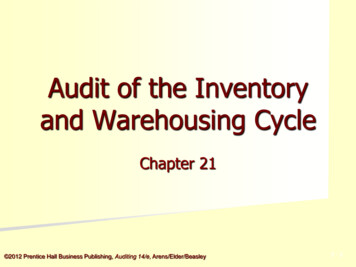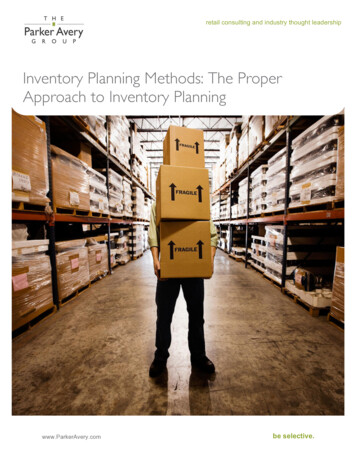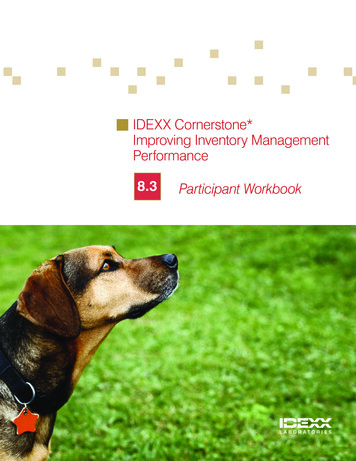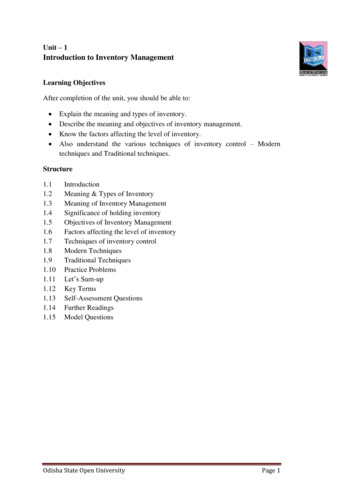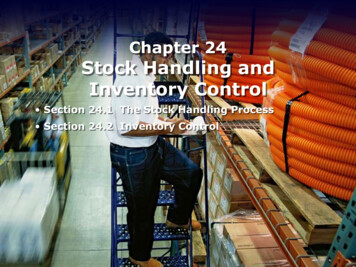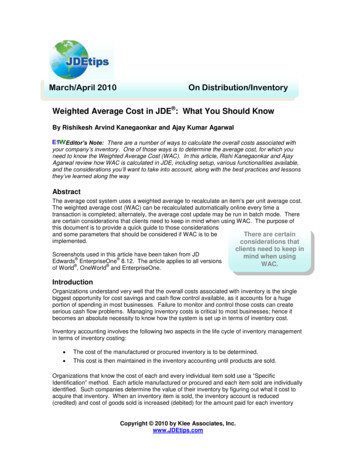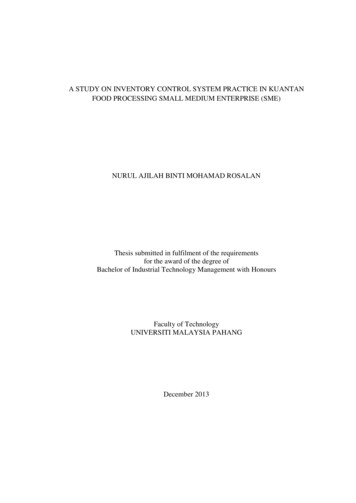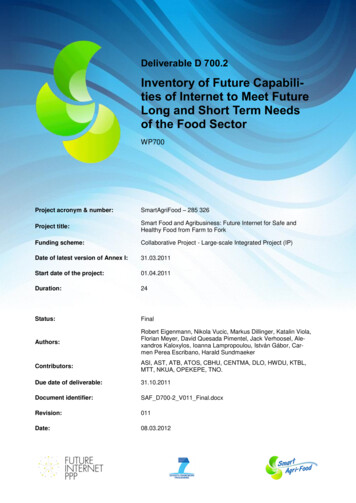
Transcription
Deliverable D 700.2Inventory of Future Capabilities of Internet to Meet FutureLong and Short Term Needsof the Food SectorWP700Project acronym & number:SmartAgriFood – 285 326Project title:Smart Food and Agribusiness: Future Internet for Safe andHealthy Food from Farm to ForkFunding scheme:Collaborative Project - Large-scale Integrated Project (IP)Date of latest version of Annex I:31.03.2011Start date of the obert Eigenmann, Nikola Vucic, Markus Dillinger, Katalin Viola,Florian Meyer, David Quesada Pimentel, Jack Verhoosel, Alexandros Kaloxylos, Ioanna Lampropoulou, István Gábor, Carmen Perea Escribano, Harald SundmaekerContributors:ASI, AST, ATB, ATOS, CBHU, CENTMA, DLO, HWDU, KTBL,MTT, NKUA, OPEKEPE, TNO.Due date of deliverable:31.10.2011Document identifier:SAF D700-2 V011 Final.docxRevision:011Date:08.03.2012
SmartAgriFood08.03.2012The SmartAgriFood ProjectThe SmartAgriFood project is funded in the scope of the Future Internet Public Private Partnerthship Programme (FI-PPP), as part of the 7 Framework Programme of the European Commission.The key objective is to elaborate requirements that shall be fulfilled by a “Future Internet” to drastically improve the production and delivery of safe & healthy food.Project SummarySmartAgriFood aims to boost application &use of Future Internet ICTs in agri-foodsector by: Identifying and describing technical,functional and non-functional Future Internet specifications for experimentation in smart agri-food production as awhole system and in particular for smartfarming, smart agri-logistics & smartfood awareness, Identifying and developing smart agrifood-specific capabilities and conceptualprototypes, demonstrating critical technological solutions including the feasibility to further develop them in large scaleexperimentation and validation, Identifying and describing existing experimentation structures and start user communitybuilding, resulting in an implementation plan for the next phase in the framework of the FIPPP programme.Project Consortium LEI Wageningen UR; NetherlandsATB Bremen; GermanyTNO; NetherlandsCentMa GmbH; GermanyAtos ORIGIN; SpainASI S.L.; SpainHuawei; GermanyMTT Agrifood Research; FinlandKTBL e.V.; GermanyNKUA; GreeceUPM; Spain Campden BRI Magyarország; HungaryAston University; United KingdomVTT; FinlandOPEKEPE; GreeceJohn Deere; GermanyWageningen University; NetherlandsEHI Retail Institute GmbH; GermanyGS1 Germany GmbH; GermanySGS S.A.; SpainBon Preu SAU; SpainMore InformationDr. Sjaak Wolfert (coordinator)LEI Wageningen URP.O. Box 356700 AA WageningenSAF D700-2 V011 Final.docxe-mail:sjaak.wolfert@wur.nlphone: 31 317 485 939mobile: 31 624 135 790www.smartagrifood.euPage 3 of 84
SmartAgriFood08.03.2012Dissemination LevelPUPublicXPPRestricted to other programme participants (including the Commission Services)RERestricted to a group specified by the consortium (including the Commission Services)COConfidential, only for members of the consortium (including the Commission Services)Change HistoryVersionNotesDate001Creation of the document27.10.2011002Including comments from NKUA (Alex, Ioanna), TNO (Jack), CBHU (Katalin)02.11.2011003Changes and additions during review meeting03.11.2011004Changes and additions from partners HWDU, ATOS, NKUA, ATB, CBHU10.11.2011005Added standards. Editorial changes21.11.2011006No changes – Release candidate23.11.2011007Shift of contents section 1.2 from D700.2 to D700.1.06.12.2011008Annex included. Update on FI applications in 4.2 (Cloud Hosting)07.12.2011010Release09.12.2011011Included extended summary and editorial changes08.03.2012SAF D700-2 V011 Final.docxPage 4 of 84
SmartAgriFood08.03.2012Executive SummaryThe Future Internet Public-Private Partnership (FI-PPP) Programme has been launched by theEuropean Commission in 2011 with the aim to increase the effectiveness of business processesand infrastructures supporting applications in different areas (e.g. food, transport, health or energy) and to derive innovative business models that strengthen the competitive position of European industry in sectors such as telecommunication, mobile devices, software and services, andcontent provision and media. It will deliver the core platform of the future internet, which will bean open architecture and a reference implementation of a novel service infrastructure, buildingupon generic and reusable building blocks. This core platform will be provided by the FI-WAREproject, which is collecting requirements from eight different usage areas. The SmartAgriFoodproject is one of the eight use case projects with the goal to identify, analyse and verify the requirements from the Agri-Food sector for the future internet. In the SmartAgriFood project,three usage areas have been identified and will be handled in parallel in order to deep-dive intothe technical challenges of the specific usage requirements: Smart Farming, which is dealingwith the efficient food production, Smart Logistics, which handles the transportation of agricultural products and Smart Food Awareness, which analyses the requirements from the consumerpoint of view on transparent information about the goods.This work is performed in the scope of the Task 720 – ICT Community Involvement. Its mainpurpose is to instigate a dialogue between the agri-food and ICT worlds by informing each otherabout the existing and the planned functionalities of the Future Internet.We followed the approach to first get feedback from the food chain users on their needs and expectations on the future internet. Second, the current internet solutions and available technologies have been investigated in order to identify existing information and communication solutions that potentially can be used today. Then, the generic and reusable building blocks (the “generic enablers”) of the future internet core platform are explained to the user community, providing application examples related to the collected requirements. In order to best explain the futureinternet to the user community, technical terms have been avoided where possible and examplesin the usage areas have been provided.Future Needs of Food Chain User:In total 135 questionnaires in 6 countries and 8 focus group discussions with 69 participants in 5countries have been performed and analysed, collecting feedback on the interpretation of thefuture internet capabilities from the user’s perspective, the current use of internet applications intheir daily work and today’s problems or limitations resulting in the expectations and requirements to the future internet.The test showed that the most important function of the Future Internet is the protection of private data: Ensuring of safety and security of data and information is been seen as the essentialelement of the Future Internet. Most of the users were worried about unauthorized use of theirdata, when enabling functionalities like cloud hosting. Availability of databases should be regulated and controlled to guarantee the data security and protection. Second important function isthe interoperability of networking devices: The professional users require that services and business processes should be available and maintainable on any equipment or device, independentfrom the location. Further demands address the affordability of Internet solutions and devices,which is expressed especially from small and medium enterprise stakeholders. It is expected thatespecially the cloud hosting services will provide benefit for small enterprises, which need notinvestment in installation and maintenance of IT infrastructures. However, the cloud hosting onthe other hand is seen as a potential risk for data security and privacy.SAF D700-2 V011 Final.docxPage 5 of 84
SmartAgriFood08.03.2012Just a few respondents use really advanced internet technologies available already today. Themajority of the respondents use basic and simple systems and applications as mailing systems,browsers and web-sites, or proprietary tools. It may be concluded that the potential benefits ofthe Internet to simplify work processes, support interactions of different stakeholders and enrichthe work with supporting information is not yet transparent to the stakeholders. When suggestingconcrete potential Future Internet applications to the users, the response became more specific:From the farming perspective, especially an intelligent advisory system had been identified as animportant application for supporting lots of daily decisions to be made on how to treat plants,prevent diseases or include surrounding information such as weather services. Many of thesementioned applications or systems are already applied in farms, but not wide-spread, because oftheir costs.For the logistics section of transportation and distribution of food, appealing Future Internet applications are to share online monitoring information from trucks during the transport of cargo, aflexible solution for on-demand dock reservation and an integrated freight and fleet management.In general, all the selected applications have the same practical benefits as cost reduction, bettercoordination and better information for decision making, and the proactive control of processesleading to increasing efficiency and effectiveness. Today there are limitations, as data needs tobe joined and connected through different applications and systems. The lack of standardizedinterfaces and processes needs to be solved in parallel to the Future Internet functionality.In the food awareness area, the food tracing capability is seen to be the most important topic,providing knowledge about the origin, production and treatment of products. The customer expects to get the information with an easy and configurable interface, extended with an advisoryfunctionality based on individual customer preferences. According to the logistics area, today’ssolutions are hindered by missing standards on data interfaces and processes. In addition, thewidespread use of the RFID tags or QR codes needs to available at a low cost.Available Internet FunctionalitiesToday’s Internet already provides a wide range of functionalities, services or applications, whichare already applied - or could be more intensively applied in the agriculture business. The “Internet” is regarded as the principle of information exchange based on the Internet Protocol (IP),covering carrier networks (e.g. LAN or mobile networks), client/server solutions (e.g. databaseservers and reporting clients), network devices (e.g. PCs, smartphones), services (e.g. voice calls,Email, WEB-browsing), applications (e.g. Google search, Wikipedia) and security (e.g. data encryption, authentication).With regard to the main user requirements stated previously, data from different locations haveto be linked and joined, while at the same time guaranteeing data access policies. Today’s cloudproducts, data warehouse services and policy management solutions already provide the platformfor this requirement, even with the potential to restrict IT costs for small companies through“renting” of the infrastructure or software on demand. However, existing solutions are specificand proprietary, mostly having their own specifications about the functionality they provide andthe means to interwork with other services. Further, there is not yet a pan-European solution fore-government services, providing secure authentication and authorization functions to users,which are essential for trading, payment, privacy, liability, service subscriptions and a userfriendly “single-sign-on” feature.SAF D700-2 V011 Final.docxPage 6 of 84
SmartAgriFood08.03.2012The Future InternetWith the FI-WARE project, the core platform of the Future Internet will be developed. As thebasic principle, FI-WARE is aiming to provide an open architecture which shall be applicable forany industrial area, open to any vendor and supporting the creation and delivery of any service. Itwill provide a set of commonly used functional modules (the Generic Enabler, GE) that can bere-used through a standardized Application Programming Interface (API). Although the GenericEnabler will be defined by partners in the FI-PPP project consortium, any company can providea FI-WARE compliant platform product with own pricing strategies. Through the open API andthe modular concept it will be possible to select appropriate FI-WARE platform products provider from a set of vendors. Further, there will be FI-WARE instance providers which bundle a setof FI-WARE platform products and potentially enrich the functionality with Specific Enablersfor differentiation on the market. Those FI-WARE instance products could e.g. implement a specific Agri-Food FI-WARE instance by integrating domain specific services, e.g. the link toweather forecasting services or the interface to specific databases for e.g. tracking and tracing.Finally, FI-WARE applications on top of a FI-WARE instance will provide the tools for the users.The generic Enabler and their relevance to AgriFood are: Cloud Hosting: The “Cloud Hosting” concept is the basic enabler for providing scalablecomputation, software, data access, and storage services. With a cloud, users can rent software as a service or only an infrastructure (e.g. data storage), keeping investments for smallcompanies low. Small software companies will be competitive, as the cloud provides thepossibility to focus on the application development without the need to implement a fullfunctional platform. This also reduces time to market for new developments. Data/Context Management: The Data and Context management implements facilities fortransfer, conversion, storage, analysis and access of huge amount of data through the cloud.Further, instead of just processing “data”, the meaning of the data is linked, allowing endusers to interpret the data in the context. This functional block will enable a manifold of applications, e.g. intelligent decision support systems for farming or logistics, video or imageprocessing for surveillance of the product quality or the integration of food or product specific ontologies or vocabulary. Internet of Things Services Enablement: Instead of only connecting computers and servers,the internet of things (IoT) takes all physical objects into account and extends the capabilitiesof entities to process information autonomously, react proactively and context sensitive totheir current environment. It will support the communication, resource management, datahandling and process automation of sensors, RFID systems, or pee-to-peer machinery communication. It would support scenarios of e.g. online greenhouse management, remote machinery diagnostics or tracking of goods and their quality. Applications/Services Ecosystem and Delivery Framework: These GEs will enable the creation, composition, delivery, monetization, and usage of applications and services on the Future Internet. It also supports business aspects related to the service provisioning, such as offering, accounting, billing and SLAs. Through composition of components developed andprovided by different parties, new services tailored to the needs of specific usage areas can beprovided. It offers the potential for e.g. Farm Management Systems, virtual market places forgoods and services (e.g. transportation, spraying), legal compliancy and quality certifications,advisory services (e.g. e-veterinarian) or discussion groups of stakeholders. Interface to Networks and Devices: A broad range of devices will be enabled to communicatein the Future Internet through any wireless or fixed physical network connection at any place.Users will have their working environment and their applications, independent of the device,the location, the service provider or local (legacy) infrastructure. This enabler ensures one ofSAF D700-2 V011 Final.docxPage 7 of 84
SmartAgriFood 08.03.2012the top priority demands of the food chain users, having a seamless service anywhere and anytime with any device.Security: Common to any application is the strong requirement of privacy, integrity and security, providing the foundation to get acceptance and trust from all stakeholders. It handles aspects of encryption, data access policies, fraud- and intrusion detection and identity management. The success of a manifold of Future Internet scenarios will rely on a proper implementation of the security aspects, ensuring that data will be only accessible from an authorizedset of stakeholders and for the agreed purpose.As a summary, the Future Internet will provide the missing link of today’s already available(mostly) proprietary solutions through a open architecture and standardized interfaces. This allows a flexible composition of services to specific solutions in the Agriculture business. The enablers are fully supporting the demands of the food chain users in terms of a technical platform.However, the Future Internet will not solve the issue of missing domain-specific standards (e.g.vocabularies, certificates, processes), which are required to have an end-to-end transparency offood and related attributes.The deliverable is organized in the following way. The introductory Section 1 starts by brieflysummarizing the detected user needs in the food sector, as well as their expectations from the FI.This section is complemented by an overview of general FI trends and their potential reflectionsin agriculture-related applications from the ICT experts’ point of view. The following Sections2-4 focus on the three sub-usage areas of Smart Farming, Smart Agri-Logistics, and Smart FoodAwareness defined in the SmartAgriFood project. In these sections, firstly, the possibilities ofthe ICT solutions, which are already available but seem to be underused, are presented. This isfollowed by explanations of the envisioned FI generic enablers (GEs). The GEs in this documentare mainly based on the related work of the FI-WARE (Core Platform) project in the FI PPPprogramme. The explanations of the enablers are of high-level nature and encompass a minimumamount of technical details necessary to understand the matter. As these GEs are applicable inmany fields of interest (energy, environment protection, multimedia, .), their presentation istailored to the above-mentioned agricultural sub-usage areas at hand. The exposition is illustratedby a number of potential applications of these enablers in the respective areas, proposed by theICT partners in the SmartAgriFood project. Finally, the report is concluded in Section 5.SAF D700-2 V011 Final.docxPage 8 of 84
SmartAgriFood08.03.2012Abbreviations3GPP3rd Generation Partnership ProjectIETFInternet Engineering Task ForceAAAAuthentication, Authorization, andAccountingIoTInternet of ThingsIPInternet ProtocolA-GPSAssisted GPSIPInternet ProtocolAPIApplication Programming InterfaceISOBUSData bus mainly used in agricultural application. Compliant to ISO11783CAPEXCapital ExpendituresCDIConnected Devices InterfaceITinformation technologyCTcommunication technologyITUInternational TelecommunicationUnionDDeliverableE2EEnd to EndLANLocal Area NetworkEDIElectronic Data InterchangeLTELong Term EvolutionEDI-teeltDutch standard for data exchangein arable farmingM2MMachine to MachineMANETMobile Ad-Hoc NetworkEICElectronic Identity CardNetICNetwork Information and ControleIDElectronic IdentityNFCNear Field CommunicationEPCEvolved Packet CoreOLAPOnline Analytical ProcessingEPoSElectronic Point of SaleOWLWeb Ontology LanguageERPEnterprise Resource PlanningP2PPeer to PeerETLExtraction, Transformation, LoadPaaSPlatform as a ServiceETSIEuropean TelecommunicationsStandards InstitutePALMPrecision Agriculture Markup LanguageFIFuture InternetPDAPersonal Digital AssistantFI-PPPFuture Internet Public PrivatePartnershipPINPersonal Identification NumberQoEQuality of ExperienceFI-WAREFuture Internet (FI) Core PlatformProjectQoSQuality of ServiceFMISFarm Management InformationSystemQR codeQuick Re
neric enablers”) of the future internet core platform are explained to the user community, provid- . data, when enabling functionalities like cloud hosting. Availability of databases should be regu- . data warehouse services and


